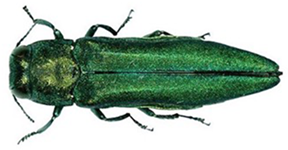Garden News September 2021

- Time to plant shrubs and trees
- THPRD Fall Native Plant Sale by pre-order only
- Be on the lookout for emerald ash borer (Agrilus planipennis)
Time to plant shrubs and trees
By Margie Lachman
Summer is going by so quickly. Autumn will be here before we know it and, hopefully our normal rainfall. Starting in mid-September the weather is great for planting trees, shrubs and perennials. The soil is warm, and days are shorter.
Growth above ground slows as plants get ready for winter dormancy but roots continue to develop underground. Next spring these new plants will take off and grow.
Autumn is a slower time for nursery sales, so usually many plants are offered at reduced prices. That tree or shrub you like could be a bargain at the end of summer. It will have weeks to settle into its new home before the weather cools down. I have had great success adding new plants to my garden at this time of the year.
Choose a place where the plant will receive the right amount of sun or shade and make sure there will be adequate room after 10 years of growth. Make sure you’ll be able to provide extra water to the plant during establishment.
Soaking the plant in a bucket of water added up to the soil level for 20 minutes before you plant it greatly reduces transplant shock. While the plant is soaking dig a hole to the same depth as the pot so the plant will be at the same depth when in the ground. Make the hole twice as wide as the pot to allow the roots to spread. To check for optimum drainage fill the hole with water. It should drain away in 30 minutes, but if it doesn’t, loosen the soil at the bottom and add an inch of chicken or turkey grit and mix into the soil.
With the pot on its side, remove the plant gently and check the roots. Trim any broken ones or roots that circle around soil. They indicate that the plant is becoming root-bound and will continue to grow in a circle. Gently loosen the roots, trimming any that are circling the root ball. Cutting them stimulates new root growth. Loosening them encourages them to grow into surround soil.
You can now add your tree or shrub and fill in soil around it, firming the soil to eliminate air pockets. Water around the plant and you are finished. A layer of mulch, like compost, will help retain soil moisture and reduce weeds. Check weekly and water if needed.
Your new plant should be growing well next spring. Any tree or shrub should be watered once a week for the first year after planting until a good root system is established.
Questions? email me at margierose2.com or call 503-645-2994
THPRD Fall Native Plant Sale by pre-order only
Pre-order window ends on Wednesday, September 15
Plant pick-up: Friday, October 8 and Saturday, October 9, Tualatin Hills Nature Park, 15655 SW Millikan Way
These climate-resilient plants will enhance your garden, allowing it to best support pollinators and wildlife. Sparrowhawk offers thousands of habitat-friendly native plants as well as information about their benefits. Select from 100 species of premium-quality native plants.
Easy Guide to Fall Native Plant Sale:
Step 1: Select your plants and order from August 15 through September 15; Step 2: Select the date and time you want to pick up your plants (Friday, October 8 or Saturday, October 9); Step 3: Visit the Tualatin Hills Nature Park to pick up your plants
www.sparrowhawknativeplants.com
Be on the lookout for emerald ash borer (Agrilus planipennis)
From the West Multnomah Soil & Water Conservation District newsletter (visit the site to sign up for their news)
Emerald ash borer (Agrilus planipennis) (EAB) is a small, brilliant metallic green beetle about half an inch long and native to north-east Asia that was unintentionally introduced to the U.S. around 2002, likely in ash wood used in cargo shipping. The insect has since had a devastating effect on all species of ash trees in North America, in both natural woodlands and cities. It is currently detected in 35 states, mainly in the Midwest and northeast, and 5 Canadian provinces.

EAB has spread from people moving firewood, logs, or ash trees from nurseries, as well as by the natural movement of the insect. There is great concern that this damaging insect could jump all the way from Colorado to Oregon via firewood, a concern held for the spread of multiple invasive insects, which is why firewood should only be purchased locally. EAB could cause immense harm to our forested wetlands since Oregon ash (Fraxinus latifolia) is the primary tree species that occupies such habitats, and it is highly vulnerable to attack by Emerald ash borer.
Due to the level of concern, a local partnership effort—initially coordinated by Oregon Department of Agriculture, and now by the Portland office of the U.S. Department of Agriculture, Animal and Plant Health Inspection Service (APHIS) – is in place to watch for the insect in our region. Because of our familiarity with the local landscape and connections to local landowners, WMSWCD was asked to get involved. WMSWCD is contributing to the effort by deploying and checking traps in our district and then identifying collected insect samples, following established guidelines. These guidelines inform where traps should be set and how and when to check them. Read more about what happens if EAB is found in Oregon, and see photos of how we check the traps.





